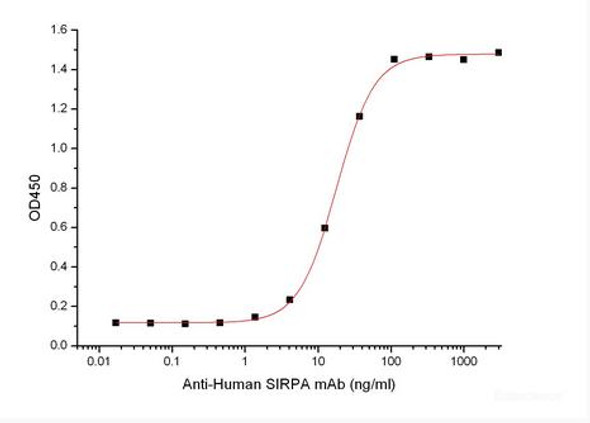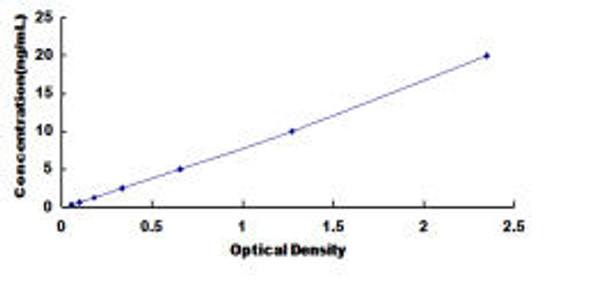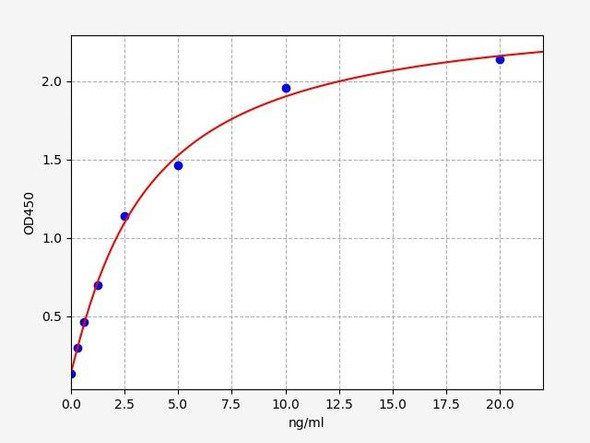Human SIRPA (Signal Regulatory Protein Alpha) ELISA Kit (HUES02584)
- SKU:
- HUES02584
- Product Type:
- ELISA Kit
- Size:
- 96 Assays
- Uniprot:
- P78324
- Sensitivity:
- 0.09ng/mL
- Range:
- 0.16-10ng/mL
- ELISA Type:
- Sandwich
- Synonyms:
- BIT, CD172A, MFR, MYD-1, P84, PTPNS1, SHPS1, SIRP,Tyrosine-protein phosphatase non-receptor type substrate 1
- Reactivity:
- Human
- Sample Type:
- Serum, plasma and other biological fluids
- Research Area:
- Cell Biology
Description
Human SIRPA (Signal Regulatory Protein Alpha) ELISA Kit
The Human SIRPA (Signal Regulatory Protein Alpha) ELISA Kit is specifically designed for the precise quantification of SIRPA levels in human samples including serum, plasma, and cell culture supernatants. This kit is known for its high sensitivity and specificity, ensuring accurate and reproducible results that are essential for a variety of research applications.SIRPA, also known as SHPS1, is a transmembrane glycoprotein that plays a critical role in regulating immune response and cell signaling.
It is involved in processes such as phagocytosis, cell adhesion, and immune cell activation. Dysregulation of SIRPA has been implicated in autoimmune disorders, cancer, and inflammatory diseases, making it a valuable biomarker for studying these conditions and identifying potential therapeutic targets.Overall, the Human SIRPA ELISA Kit offers researchers a reliable tool for studying the role of SIRPA in various diseases and developing targeted therapies to modulate its activity.
| Assay type: | Sandwich |
| Format: | 96T |
| Assay time: | 4.5h |
| Reactivity: | Human |
| Detection Method: | Colormetric |
| Detection Range: | 0.16-10 ng/mL |
| Sensitivity: | 0.10 ng/mL |
| Sample Volume Required Per Well: | 100µL |
| Sample Type: | Serum, plasma and other biological fluids |
| Specificity: | This kit recognizes Human SIRPA in samples. No significant cross-reactivity or interference between Human SIRPA and analogues was observed. |
This ELISA kit uses Sandwich-ELISA as the method. The micro ELISA plate provided in this kit has been pre-coated with an antibody specific to Human SIRPA. Standards or samples are added to the appropriate micro ELISA plate wells and combined with the specific antibody. Then a biotinylated detection antibody specific for Human SIRPA and Avidin-Horseradish Peroxidase (HRP) conjugate are added to each micro plate well successively and incubated. Free components are washed away. The substrate solution is added to each well. Only those wells that contain Human SIRPA, biotinylated detection antibody and Avidin-HRP conjugate will appear blue in color. The enzyme-substrate reaction is terminated by adding Stop Solution and the color turns yellow. The optical density (OD) is measured spectrophotometrically at a wavelength of 450 nm ± 2 nm. The OD value is proportional to the concentration of Human SIRPA. The concentration of Human SIRPA in samples can be calculated by comparing the OD of the samples to the standard curve.
| UniProt Protein Function: | SHPS1: Immunoglobulin-like cell surface receptor for CD47. Acts as docking protein and induces translocation of PTPN6, PTPN11 and other binding partners from the cytosol to the plasma membrane. Supports adhesion of cerebellar neurons, neurite outgrowth and glial cell attachment. May play a key role in intracellular signaling during synaptogenesis and in synaptic function. Involved in the negative regulation of receptor tyrosine kinase-coupled cellular responses induced by cell adhesion, growth factors or insulin. Mediates negative regulation of phagocytosis, mast cell activation and dendritic cell activation. CD47 binding prevents maturation of immature dendritic cells and inhibits cytokine production by mature dendritic cells. Binds PTPN11 when tyrosine-phosphorylated, except in macrophages, where it primarily binds PTPN6. Binds GRB2 in vitro. Binds FGR. Binds JAK2 irrespective of its phosphorylation status and forms a stable complex. Binds SCAP1 and/or SCAP2. The resulting complex recruits FYB. Binds PTK2B. Ubiquitous. Highly expressed in brain. Detected on myeloid cells, but not T-cells. Detected at lower levels in heart, placenta, lung, testis, ovary, colon, liver, small intestine, prostate, spleen, kidney, skeletal muscle and pancreas. 3 isoforms of the human protein are produced by alternative splicing. |
| UniProt Protein Details: | Protein type:Cell surface; Motility/polarity/chemotaxis; Cell adhesion; Receptor, misc. ; Membrane protein, integral Chromosomal Location of Human Ortholog: 20p13 Cellular Component: membrane; integral to membrane; plasma membrane Molecular Function:SH3 domain binding Biological Process: blood coagulation; cell adhesion; leukocyte migration |
| NCBI Summary: | The protein encoded by this gene is a member of the signal-regulatory-protein (SIRP) family, and also belongs to the immunoglobulin superfamily. SIRP family members are receptor-type transmembrane glycoproteins known to be involved in the negative regulation of receptor tyrosine kinase-coupled signaling processes. This protein can be phosphorylated by tyrosine kinases. The phospho-tyrosine residues of this PTP have been shown to recruit SH2 domain containing tyrosine phosphatases (PTP), and serve as substrates of PTPs. This protein was found to participate in signal transduction mediated by various growth factor receptors. CD47 has been demonstrated to be a ligand for this receptor protein. This gene and its product share very high similarity with several other members of the SIRP family. These related genes are located in close proximity to each other on chromosome 20p13. Multiple alternatively spliced transcript variants have been determined for this gene. [provided by RefSeq, Jul 2008] |
| UniProt Code: | P78324 |
| NCBI GenInfo Identifier: | 91105764 |
| NCBI Gene ID: | 140885 |
| NCBI Accession: | NP_001035111. 1 |
| UniProt Secondary Accession: | P78324,O00683, O43799, Q8N517, Q8TAL8, Q9H0Z2, Q9UDX2 Q9UIJ6, Q9Y4U9, A2A2E1, A8K411, B2R6C3, |
| UniProt Related Accession: | P78324 |
| Molecular Weight: | 54,967 Da |
| NCBI Full Name: | tyrosine-protein phosphatase non-receptor type substrate 1 |
| NCBI Synonym Full Names: | signal-regulatory protein alpha |
| NCBI Official Symbol: | SIRPA |
| NCBI Official Synonym Symbols: | BIT; MFR; P84; SIRP; MYD-1; SHPS1; CD172A; PTPNS1 |
| NCBI Protein Information: | tyrosine-protein phosphatase non-receptor type substrate 1; myd-1 antigen; inhibitory receptor SHPS-1; macrophage fusion receptor; CD172 antigen-like family member A; tyrosine phosphatase SHP substrate 1; brain-immunoglobulin-like molecule with tyrosine-b |
| UniProt Protein Name: | Tyrosine-protein phosphatase non-receptor type substrate 1 |
| UniProt Synonym Protein Names: | Brain Ig-like molecule with tyrosine-based activation motifs; Bit; CD172 antigen-like family member A; Inhibitory receptor SHPS-1; Macrophage fusion receptor; MyD-1 antigen; Signal-regulatory protein alpha-1; Sirp-alpha-1; Signal-regulatory protein alpha-2; Sirp-alpha-2; Signal-regulatory protein alpha-3; Sirp-alpha-3; p84 |
| Protein Family: | Nonribosomal peptide synthetase |
| UniProt Gene Name: | SIRPA |
| UniProt Entry Name: | SHPS1_HUMAN |
As the OD values of the standard curve may vary according to the conditions of the actual assay performance (e. g. operator, pipetting technique, washing technique or temperature effects), the operator should establish a standard curve for each test. Typical standard curve and data is provided below for reference only.
| Concentration (ng/mL) | O.D | Average | Corrected |
| 10 | 2.318 2.34 | 2.329 | 2.257 |
| 5 | 1.53 1.538 | 1.534 | 1.462 |
| 2.5 | 0.94 0.922 | 0.931 | 0.859 |
| 1.25 | 0.391 0.407 | 0.399 | 0.327 |
| 0.63 | 0.259 0.247 | 0.253 | 0.181 |
| 0.32 | 0.18 0.158 | 0.169 | 0.097 |
| 0.16 | 0.12 0.124 | 0.122 | 0.05 |
| 0 | 0.069 0.075 | 0.072 | -- |
Precision
Intra-assay Precision (Precision within an assay): 3 samples with low, mid range and high level Human SIRPA were tested 20 times on one plate, respectively.
Inter-assay Precision (Precision between assays): 3 samples with low, mid range and high level Human SIRPA were tested on 3 different plates, 20 replicates in each plate.
| Intra-assay Precision | Inter-assay Precision | |||||
| Sample | 1 | 2 | 3 | 1 | 2 | 3 |
| n | 20 | 20 | 20 | 20 | 20 | 20 |
| Mean (ng/mL) | 0.47 | 1.43 | 3.70 | 0.48 | 1.56 | 3.78 |
| Standard deviation | 0.03 | 0.06 | 0.11 | 0.03 | 0.07 | 0.16 |
| C V (%) | 6.38 | 4.20 | 2.97 | 6.25 | 4.49 | 4.23 |
Recovery
The recovery of Human SIRPA spiked at three different levels in samples throughout the range of the assay was evaluated in various matrices.
| Sample Type | Range (%) | Average Recovery (%) |
| Serum (n=5) | 95-106 | 100 |
| EDTA plasma (n=5) | 93-107 | 100 |
| Cell culture media (n=5) | 87-97 | 92 |
Linearity
Samples were spiked with high concentrations of Human SIRPA and diluted with Reference Standard & Sample Diluent to produce samples with values within the range of the assay.
| Serum (n=5) | EDTA plasma (n=5) | Cell culture media (n=5) | ||
| 1:2 | Range (%) | 98-110 | 94-109 | 88-98 |
| Average (%) | 105 | 99 | 93 | |
| 1:4 | Range (%) | 88-100 | 83-94 | 83-96 |
| Average (%) | 95 | 88 | 89 | |
| 1:8 | Range (%) | 93-105 | 86-97 | 85-96 |
| Average (%) | 99 | 92 | 90 | |
| 1:16 | Range (%) | 88-104 | 85-98 | 87-101 |
| Average (%) | 96 | 92 | 93 |
An unopened kit can be stored at 4°C for 1 month. If the kit is not used within 1 month, store the items separately according to the following conditions once the kit is received.
| Item | Specifications | Storage |
| Micro ELISA Plate(Dismountable) | 8 wells ×12 strips | -20°C, 6 months |
| Reference Standard | 2 vials | |
| Concentrated Biotinylated Detection Ab (100×) | 1 vial, 120 µL | |
| Concentrated HRP Conjugate (100×) | 1 vial, 120 µL | -20°C(shading light), 6 months |
| Reference Standard & Sample Diluent | 1 vial, 20 mL | 4°C, 6 months |
| Biotinylated Detection Ab Diluent | 1 vial, 14 mL | |
| HRP Conjugate Diluent | 1 vial, 14 mL | |
| Concentrated Wash Buffer (25×) | 1 vial, 30 mL | |
| Substrate Reagent | 1 vial, 10 mL | 4°C(shading light) |
| Stop Solution | 1 vial, 10 mL | 4°C |
| Plate Sealer | 5 pieces | |
| Product Description | 1 copy | |
| Certificate of Analysis | 1 copy |
- Set standard, test sample and control (zero) wells on the pre-coated plate and record theirpositions. It is recommended to measure each standard and sample in duplicate. Note: addall solutions to the bottom of the plate wells while avoiding contact with the well walls. Ensuresolutions do not foam when adding to the wells.
- Aliquot 100µl of standard solutions into the standard wells.
- Add 100µl of Sample / Standard dilution buffer into the control (zero) well.
- Add 100µl of properly diluted sample (serum, plasma, tissue homogenates and otherbiological fluids) into test sample wells.
- Cover the plate with the sealer provided in the kit and incubate for 90 min at 37°C.
- Aspirate the liquid from each well, do not wash. Immediately add 100µL of BiotinylatedDetection Ab working solution to each well. Cover the plate with a plate seal and gently mix. Incubate for 1 hour at 37°C.
- Aspirate or decant the solution from the plate and add 350µL of wash buffer to each welland incubate for 1-2 minutes at room temperature. Aspirate the solution from each well andclap the plate on absorbent filter paper to dry. Repeat this process 3 times. Note: a microplatewasher can be used in this step and other wash steps.
- Add 100µL of HRP Conjugate working solution to each well. Cover with a plate seal andincubate for 30 min at 37°C.
- Aspirate or decant the solution from each well. Repeat the wash process for five times asconducted in step 7.
- Add 90µL of Substrate Reagent to each well. Cover with a new plate seal and incubate forapproximately 15 min at 37°C. Protect the plate from light. Note: the reaction time can beshortened or extended according to the actual color change, but not by more than 30min.
- Add 50 µL of Stop Solution to each well. Note: Adding the stop solution should be done inthe same order as the substrate solution.
- Determine the optical density (OD value) of each well immediately with a microplate readerset at 450 nm.










